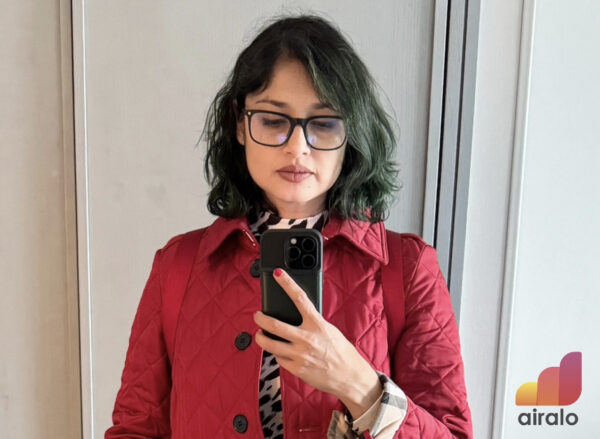This topic has been one of my most requested blog posts but I never got around to it because I hardly review the things I buy. But also, I committed to it a while back and it has been in my drafts for a while now, so here’s my experience.
I’ve been using the Rain mobile network since it launched in June 2018. It is regarded as South Africa’s first data-only network (LTE) and the pricing is simple: 5c/MB. There are no in- and out-of-bundle rates, the sneaky way regular operators make money off you and before you know it, your airtime has run out.
I’ve been on prepaid my whole life, except that one time I took out a CONtract just for the phone and never used the airtime (I’ve grown up since lol) and now I prefer to save the cash and buy my phones outright (either in SA or when I travel). I got tired of paying ridiculous data prices on my network, and the numerous times I found that when I had run out of data, it used my airtime without me knowing (I managed to get refunded a few times) but eventually I got fed up.
Rain came at the right time, it was when realised I had spent over R800 in one month on prepaid data. I was too afraid to check beyond a month and because I buy data exclusively from the FNB app, it was easy to go back and look at my transactions.

Buying a Rain SIM card
The only way to buy a Rain SIM is online, directly through their website, rain.co.za. There are no physical stores, and no retailers that stock it. So if you want one, best you sign up on the website. I paid the full price of R120 delivery at the time on launch; it is currently R1 for delivery and the SIM card is R50. You also get 1 week free usage, a great way to see if you have signal where you are going to use it the most.
I used the coverage map for an indicator but I was on the border, and subsequently only got signal outside my house, but since they added more towers I’m fully covered at home. At home signal wasn’t a huge dealbreaker for me as I have uncapped WiFi; and this was mainly for being out and about. It certainly helps when my internet is down though, which worked during load shedding.
RICA and activation
When the SIM card gets delivered, you have to provide a copy of your ID and proof of address to the delivery person. They will hand it over to Rain who will process it, then your SIM will get activated. I can’t remember how long this takes. But if you don’t hear from them after 24 hours, try the call centre or log a ticket. They will send you the settings which you need to save, and your device should start working.
Although this might seem obvious, I’m going to state it anyway. As a data only network, the SIM card can only be used for data. It cannot receive SMSes and you cannot make calls with it. This means, it cannot be used to set up a Whatsapp account, or used for Uber etc. And if you’re interested in buying one, you obviously have another primary SIM card for calls. To use it, you would need either a dual-SIM phone or a MiFi device to put it into and hotspot from. I put mine into the test phones I have and hotspot from them (Mate 20 Pro is killer for this with its long-lasting battery). But Rain and a bunch of other retailers sell these dongles.

Data cost saving
Going back to the cost, it is a flat-rate of 5c/MB and R50/GB; there are no in- and out-of-bundle rates, therefore data doesn’t “expire”; you just pay this flat rate every time you access data. The primary network I am on charges R149/GB of data, so it makes no sense for me to pay anything more on another network if I have signal where I use it the most. This happens to be in and around Sandton, which has served me well so far. I pick up 50Mbps at home and slightly less elsewhere.
There is another option you can subscribe to called “unlimited off-peak” which is R250 a month but can be used for 19 hours a day. Everything here is month-to-month, there are no bundles or subscriptions. These hours are from 11pm-6pm daily. Anything you use from 6-11pm is regular R50/GB. If you think you use more than 5GB a month, this is the option for you.
I have not yet gone above R300 a month, so I’m monitoring my usage to see if I need this package option. As a regular user, I can also set a monthly cap; mine is R300 and if I’m at 80% of it, I will get a notification reminding me (I went above it during load-shedding). Everything about Rain so far has ensured I never spend more than I’m aware of. I hardly buy data on my primary network now, unless I really need to outside of Rain coverage. My bill is typically between R60-R200 a month, and our household has 2 SIM cards.
Other issues with Rain
I had an issue a few weeks ago with speed but since putting it into another device, it appears to be ok now. But also, I’m just questioning that speed indicator on the device to begin with because the speed test showed full speed. If anyone knows anything about this, let me know. I’ve not had other major issues with Rain so I can say my experience has been great. I’m very happy with my lower data costs these past eight months.
 Image credit: Shutterstock
Image credit: Shutterstock
Is Rain worth it?
A lot of people ask me if Rain is worth it. My reply is always the same – it all comes down to cost and signal; if you have signal where you will use it the most, just get the SIM card. It costs R51 once-off (don’t buy yourself take-out coffee for 2 occasions) and there you have it. Your first week is free to use, so you won’t even be charged for the data while you decide. Use that week to determine if this is what works for you. That said, I do understand that you may need another device to hotspot from, so try use a previous phone for this, or find a deal online on a MiFi device, assuming you don’t have a dual-SIM phone.
I’m looking forward to the eSIM feature that is coming out this year, and well, 5G!
Nafisa Akabor
Related posts
ABOUT

Recharged is an independent site that focuses on technology, electric vehicles, and the digital life by Nafisa Akabor. Drawing from her 16-year tech journalism career, expect news, reviews, how-tos, comparisons, and practical uses of tech that are easy to digest. info@recharged.co.za


